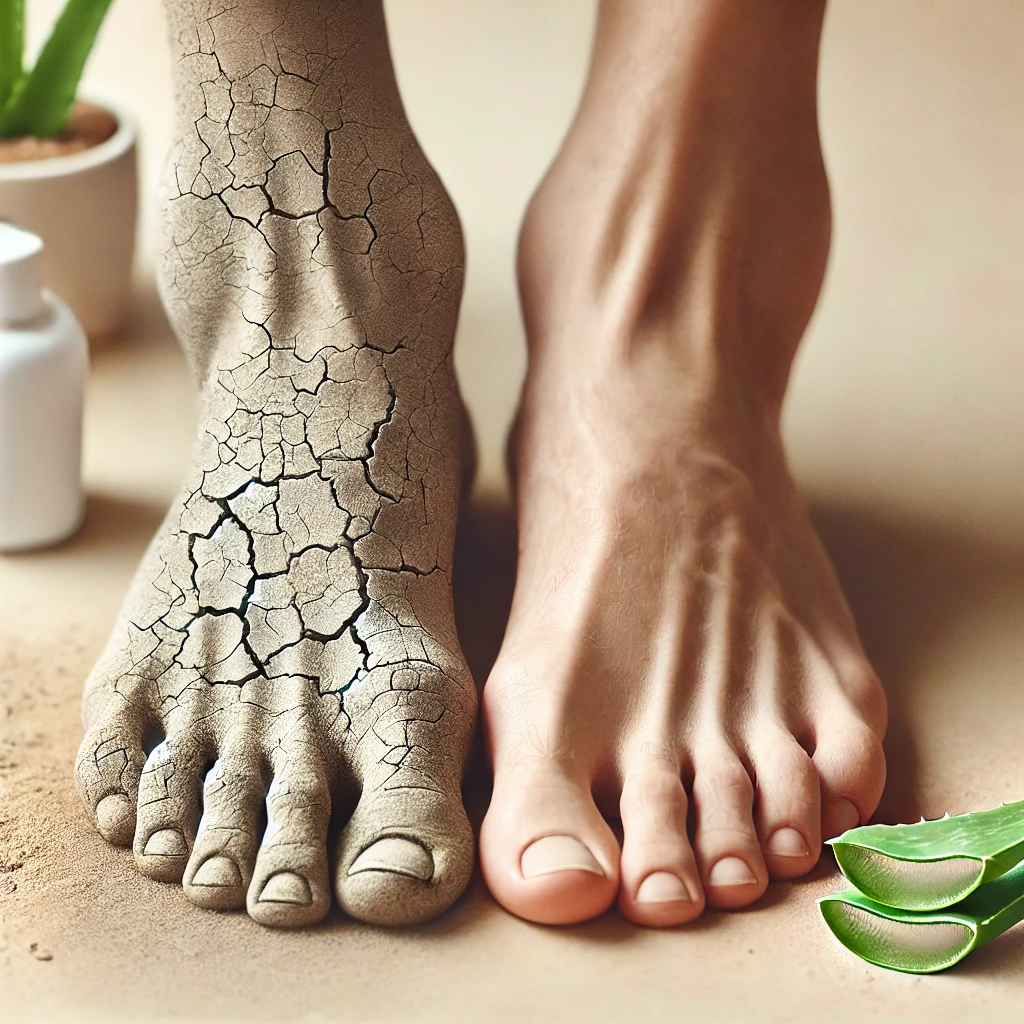Introduction
Dry, cracked feet can be both uncomfortable and unsightly. Many people struggle with dryness, flakiness, and even painful cracks in their feet, especially during colder months. While it might seem like a minor issue, ignoring dry feet can lead to more serious conditions like infections and deep fissures. Proper foot care is essential to maintaining smooth, hydrated skin.
In this article, we’ll explore the common causes of dry feet and provide effective moisturizing tips to keep them soft and healthy.
Causes of Dry Feet

1. Lack of Moisture
One of the most common causes of dry feet is a lack of moisture. Unlike other parts of the body, the feet have fewer oil glands, making them more prone to dryness. Environmental factors such as exposure to air conditioning, excessive sun, or central heating can strip away moisture, leaving feet dry and cracked.
Dehydration also plays a significant role—if you’re not drinking enough water, your skin will lose its natural hydration, leading to dryness. To combat this, keeping your feet well-moisturized and drinking plenty of fluids is crucial.
2. Harsh Soaps and Cleansers
Many soaps and body washes contain harsh chemicals that strip the skin of its natural oils. Antibacterial and scented soaps, in particular, can be drying and irritating to sensitive skin.
If you regularly wash your feet with strong cleansers, you might be worsening the problem instead of improving it. Switching to mild, moisturizing cleansers with natural ingredients can help retain moisture while keeping your feet clean.
3. Medical Conditions
Certain medical conditions can contribute to dry feet, including:
- Eczema and Psoriasis: These skin conditions cause excessive dryness, scaling, and even painful cracks.
- Diabetes: High blood sugar levels can lead to poor circulation, reducing the ability of the skin to retain moisture.
- Hypothyroidism: This condition slows down metabolism, affecting oil production and leading to dry, rough skin.
If you suspect a medical condition is causing your dry feet, consult a doctor for proper diagnosis and treatment.
4. Aging and Natural Skin Changes
As we age, our skin naturally loses moisture and elasticity. The production of sebum (natural oils) decreases, making the skin more prone to dryness. This is why older adults often experience drier feet than younger individuals.
To counteract this, regular moisturizing and gentle exfoliation can help keep feet soft and hydrated.
5. Frequent Exposure to Water
While soaking in a hot bath or standing in the shower for long periods may feel relaxing, it can actually worsen dryness. Water, especially hot water, strips the skin of its natural oils, leading to dehydration.
To prevent this, limit your foot exposure to hot water and always moisturize immediately after bathing.
6. Cold Weather and Low Humidity
Winter weather is notorious for drying out the skin, including the feet. Low humidity levels and cold temperatures can pull moisture away from the skin, leading to rough, cracked heels.
Wearing warm socks, using a humidifier, and applying a rich foot cream can help keep your feet hydrated during colder months.
7. Wearing Improper Footwear
Footwear plays a significant role in foot health. Wearing open sandals or flip-flops exposes your feet to dry air and rough surfaces, increasing moisture loss. On the other hand, tight shoes can cause excessive friction, leading to dry patches and calluses.
Opting for properly fitting shoes and breathable socks made from moisture-wicking materials can help prevent dryness.
Effective Moisturizing Tips for Dry Feet

1. Choosing the Right Moisturizer
When it comes to keeping your feet soft and hydrated, choosing the right moisturizer is key. Not all lotions and creams are created equal—some are more effective at sealing in moisture than others.
Look for moisturizers that contain:
- Urea – Helps remove dead skin while deeply hydrating.
- Glycerin – Attracts moisture to the skin and keeps it locked in.
- Shea Butter – Provides intense hydration and soothes rough patches.
- Hyaluronic Acid – Boosts moisture levels by drawing in water.
- Coconut Oil or Jojoba Oil – Natural emollients that soften and repair dry skin.
For best results, apply moisturizer to your feet twice a day—once in the morning and once before bed. If you have severely dry feet, opt for thicker creams or foot balms instead of lightweight lotions.
2. Hydrating Foot Masks and Overnight Treatments
Sometimes, a simple moisturizer isn’t enough to heal extremely dry feet. That’s where foot masks and overnight treatments come in handy.
DIY Foot Mask Recipes:
- Banana & Honey Mask – Mash one banana and mix with honey for a natural hydration boost.
- Aloe Vera & Coconut Oil Mask – Aloe vera gel soothes, while coconut oil deeply moisturizes.
- Milk & Oatmeal Mask – Exfoliates while nourishing dry, cracked skin.
To supercharge hydration, apply a thick layer of foot cream or petroleum jelly before bed, then wear moisturizing socks overnight. This locks in moisture and allows your skin to absorb the nutrients while you sleep.
3. Exfoliation to Remove Dead Skin
Dry feet often develop flaky, dead skin that prevents moisture from being absorbed. Regular exfoliation helps remove this layer, allowing moisturizers to penetrate deeper.
Best Exfoliation Methods:
- Pumice Stone – Gently rub on damp skin to remove calluses.
- Foot Scrubs – Use sugar or salt scrubs with oil for added hydration.
- Chemical Exfoliants – Look for foot creams with lactic acid or glycolic acid to break down dead skin cells.
Exfoliate 2-3 times per week to maintain soft, healthy feet. Avoid over-exfoliating, as this can lead to irritation.
4. Soaking Feet for Deep Hydration
A good foot soak can do wonders for dry, cracked feet—especially when combined with moisturizing ingredients.
Best Foot Soaks for Dry Feet:
- Epsom Salt & Lavender Oil Soak – Soothes tired feet and softens rough patches.
- Milk & Honey Soak – The lactic acid in milk gently exfoliates, while honey moisturizes.
- Oatmeal & Coconut Oil Soak – Calms irritated skin and adds deep hydration.
Soak your feet for 10-15 minutes, then pat dry and immediately apply moisturizer to lock in hydration.
5. Staying Hydrated Internally
External treatments are essential, but hydration starts from within. If your body is dehydrated, your skin—including your feet—will suffer.
Tips for Staying Hydrated:
- Drink at least 8 glasses of water per day.
- Eat foods rich in water, like cucumbers, watermelon, and oranges.
- Include healthy fats (avocados, nuts, and olive oil) in your diet to support skin health.
When your body is well-hydrated, your skin will naturally feel softer and more nourished.
6. Protecting Feet with Socks and Proper Shoes
Wearing the right footwear can make a huge difference in preventing dry feet.
Best Materials for Moisture Retention:
- Cotton Socks – Allow your feet to breathe while retaining some moisture.
- Wool Socks (for winter) – Prevents dryness caused by cold weather.
- Moisturizing Socks – Infused with hydrating ingredients to keep feet soft.
Avoid walking barefoot on rough surfaces and wear comfortable, breathable shoes to prevent moisture loss.
7. Home Remedies for Soft and Smooth Feet
If you prefer natural solutions, several home remedies can help soften and hydrate dry feet.
Best Home Remedies for Dry Feet:
- Coconut Oil – A natural moisturizer with antibacterial properties.
- Olive Oil & Sugar Scrub – Exfoliates while adding deep hydration.
- Aloe Vera Gel – Soothes and repairs cracked skin.
- Yogurt & Honey Mask – Hydrates and gently exfoliates rough patches.
Apply these remedies at least 2-3 times a week for soft, nourished feet.
Prevention Tips for Long-Term Foot Care

Keeping your feet soft and moisturized requires consistent care. Here are some tips to prevent dryness:
✅ Moisturize Daily – Never skip applying foot cream, especially before bed.
✅ Wear Protective Footwear – Avoid exposing your feet to harsh environments.
✅ Stay Hydrated – Drink plenty of water to keep your skin healthy.
✅ Use a Humidifier – Helps retain moisture in dry indoor air.
✅ Trim Calluses Gently – Use a pumice stone instead of harsh razors.
By following these simple habits, you can maintain smooth, crack-free feet all year round.
Conclusion
Dry feet are a common issue, but they don’t have to be a lifelong struggle. With the right moisturizing routine, gentle exfoliation, and protective care, you can keep your feet soft, smooth, and healthy.
Remember, hydration isn’t just about applying lotion—it’s about internal and external care. By following the tips in this guide, you can say goodbye to dry, rough feet and hello to soft, happy soles.
Frequently Asked Questions
1. How often should I moisturize my feet?
Ideally, you should moisturize your feet twice a day—once in the morning and once before bed. If your feet are extremely dry, you can apply a thick moisturizer and wear socks overnight for deep hydration.
2. Can dry feet be a sign of a serious health problem?
Yes, in some cases. If you experience persistent dryness, cracking, or pain, it could be a sign of diabetes, eczema, or hypothyroidism. If your symptoms don’t improve with regular care, consult a doctor.
3. What’s the best time to apply moisturizer?
The best time to apply moisturizer is right after a shower when your skin is still damp. This helps lock in moisture. Applying before bed also allows for overnight hydration.
4. Are there any foods that help with dry skin?
Yes! Foods rich in healthy fats (avocados, nuts, olive oil) and vitamins A, C, and E (carrots, citrus fruits, spinach) can help keep your skin—including your feet—hydrated and healthy.
5. Can foot soaks make dryness worse?
Yes, if done incorrectly. Soaking in hot water for too long can strip your skin of natural oils, leading to more dryness. Always moisturize immediately after soaking to prevent dehydration.










